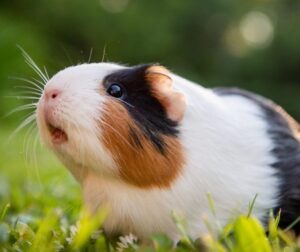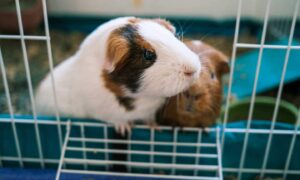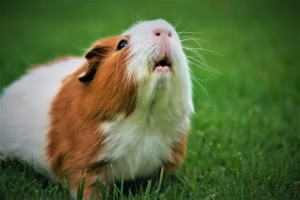Guinea pigs might be small and adorable, but their energy and curiosity can surprise even the most seasoned pet owners. One of the most common questions new guinea pig owners ask is: How high can guinea pigs jump While they’re not known for aerial feats like rabbits or cats, guinea pigs are still capable of surprising agility under the right conditions.
In this guide, we’ll explore just how high guinea pigs can jump, what factors influence their jumping ability, whether jumping is safe for them, and how to create an environment that keeps your furry friend both stimulated and secure. Whether you’re a first-time owner or a longtime guinea pig enthusiast, this guide is packed with insights you won’t want to miss.
How High Can Guinea Pigs Jump?
The Average Jumping Ability
On average, guinea pigs can jump between 10 to 30 centimeters (4 to 12 inches) in height. However, this number varies significantly depending on the guinea pig’s age, breed, health, and motivation.
Key Jumping Facts:
- Healthy adult guinea pigs can occasionally clear objects around 10 inches high.
- Young, energetic guinea pigs are more likely to leap than older or overweight ones.
- Guinea pigs typically prefer ramps and tunnels over jumping.
🐹 Real-Life Example: Some guinea pig owners have reported their pets jumping out of playpens with walls as high as 12 inches especially when excited or startled.
Do Guinea Pigs Like to Jump?
Guinea pigs aren’t natural jumpers like rabbits. Their body shape—short legs, stout torso—makes leaping an effort. However, guinea pigs will jump when:
- Trying to escape an enclosure.
- Navigating uneven terrain or obstacles in their environment.
- Playing or reacting to sudden excitement (sometimes called “popcorning”).
Popcorning: The Joy Jump
If you’ve ever seen your guinea pig suddenly jump straight up and land awkwardly, that’s “popcorning”—a common behavior in happy or energetic young pigs. While it looks like jumping, popcorning is more of a spontaneous, reflexive burst of energy than a calculated leap.
Factors That Affect a Guinea Pig’s Jumping Height
1. Age: Why Younger Guinea Pigs Jump More

Age plays a big role in how active and jumpy your guinea pig might be. Younger guinea pigs are usually more curious, playful, and full of energy. Because of this, they’re more likely to explore their surroundings and that can include jumping over small obstacles or trying to climb out of their enclosure.
They may leap during playtime, especially if they get excited or are feeling adventurous. This behavior is completely normal and is often a sign of a happy, healthy guinea pig.
On the other hand, older guinea pigs tend to slow down. They might prefer to nap or relax rather than jump or climb. As guinea pigs age, their joints may become stiff, and their energy levels naturally decrease, making jumping more difficult or even uncomfortable for them.
Key Takeaways:
- Young guinea pigs = more jumps and energy.
- Older guinea pigs = less jumping, more rest.
- Always adjust your guinea pig’s play area based on their age and mobility.
💡 Helpful Tip: If you have a young guinea pig, make sure their enclosure has high enough walls or a secure lid they may surprise you with how high they can jump!
2. Health & Weight: How They Affect Your Guinea Pig’s Ability to Jump

Just like humans, a guinea pig’s health and weight have a big impact on how well they can move—and that includes jumping. If a guinea pig is overweight or not in good shape, it can be hard for them to lift their little bodies even a few inches off the ground. Their extra weight makes movement harder and puts more pressure on their legs and joints.
Health problems like arthritis or joint stiffness can also make it painful or nearly impossible for them to jump. These issues are more common in older guinea pigs, but younger ones can also face mobility problems if they’ve had injuries or aren’t getting proper care.
When a guinea pig is carrying too much weight, even basic activities like walking, climbing, or hopping over a small step can become difficult. It’s not that they don’t want to jump it’s that they physically can’t, or it’s too uncomfortable to try.
Signs Your Guinea Pig Might Be Struggling:
- Hesitating or refusing to move around their enclosure.
- Avoiding ramps or ledges they used to climb.
- Sitting still more often than usual.
- Limping or showing signs of pain when walking.
What You Can Do:
- Provide a healthy diet with the right balance of hay, vegetables, and pellets.
- Encourage gentle movement with floor time or obstacle-free play areas.
- Visit a vet if you notice changes in their mobility, weight, or energy levels.
🐹 Friendly Tip: A healthy guinea pig is more likely to be playful, active, and maybe even show off a few little jumps! Keeping their weight in check helps them stay happy and mobile.
3. Enclosure Design: How Your Guinea Pig’s Home Encourages Jumping

The way your guinea pig’s enclosure is set up can make a big difference in how active they are—and how often they jump or climb. Guinea pigs that live in a well-designed, stimulating environment with different levels, platforms, or ramps are more likely to be comfortable with mild climbing and small jumps. This kind of setup encourages them to explore, move around more, and stay active.
When guinea pigs have things like hideouts, step-ups, tunnels, or mini ramps inside their cage, they naturally get used to gentle climbing. Over time, they might even learn to hop onto low platforms or over small obstacles. These aren’t high jumps, but they are a form of natural movement that keeps them healthy and happy.
On the other hand, guinea pigs kept in flat, boring cages with no stimulation often don’t develop these behaviors. If they’re not used to climbing or jumping, they may be hesitant or unsure about trying even if they’re physically capable.
Ways to Make the Enclosure More Stimulating:
- Add safe ramps or steps (not too steep).
- Include low platforms or ledges (just a few inches high).
- Place tunnels and hidey-houses at different heights.
- Use soft bedding in case of slips or short jumps.
- Give them space to move around and explore.
Keep in Mind:
- Avoid high platforms or steep drops. Guinea pigs aren’t great at handling heights and can get injured from falling.
- Always supervise new setups to make sure your guinea pig is comfortable and safe.
🏠 Fun Fact: A guinea pig with an enriching home is more likely to stay active, curious, and physically fit. It’s like giving them their own little playground!
4. Breed Differences: Why Some Guinea Pigs Jump More Than Others

Not all guinea pigs are the same when it comes to energy and athletic ability. In fact, the breed of your guinea pig can affect how active and agile they are, which includes how often they climb, explore, or attempt little jumps.
For example, Abyssinian guinea pigs are known to be more playful, energetic, and curious. They often enjoy moving around, exploring their space, and may even try small jumps from time to time. Their short coats and lighter frame can make it easier for them to stay active.
On the other hand, breeds like Peruvian or Teddy guinea pigs are usually less agile. This is not because they’re lazy—it’s more about their physical structure. Peruvian guinea pigs have long, flowing coats that can weigh them down a bit and limit their movement. Teddy guinea pigs have a rounder, more compact body that can make jumping or climbing a little more challenging.
So if your guinea pig doesn’t seem interested in jumping or climbing, it could simply be their breed’s natural tendency—not a sign that something’s wrong.
Common Breed Behaviors:
- Abyssinian – Very active, curious, and loves to explore. More likely to jump or climb.
- Peruvian – Calm and gentle; long coat can make movement harder.
- Teddy – Cuddly and sweet; prefers staying close to the ground.
What You Can Do:
- Choose enclosure designs that suit your guinea pig’s breed and comfort level.
- Don’t force your guinea pig to jump or climb if they seem hesitant.
- Focus on mental stimulation and gentle exercise for less active breeds.
🐾 Gentle Reminder: Every guinea pig is unique, and some just prefer lounging over leaping. As long as they’re healthy and happy, that’s perfectly okay!
Is Jumping Dangerous for Guinea Pigs?
The Risks of High Jumps
While small hops are usually safe, falls from elevated platforms or enclosures can be dangerous due to their fragile bones and poor depth perception. Guinea pigs are not built for high-impact landings.
Potential Injuries Include:
- Sprains or fractures.
- Internal injuries.
- Stress and anxiety.
⚠️ Important: Never assume your guinea pig can safely land a jump. Always err on the side of caution when designing cages and playpens.
How to Prevent Guinea Pig Escape Jumps
Tips for a Safe Enclosure:
- Minimum wall height: Use enclosures with walls at least 14 to 16 inches high.
- Lid or mesh covers: Consider using mesh lids to prevent escape without restricting airflow.
- Avoid ledges: Do not place guinea pigs on furniture or beds where a fall could injure them.
- Secure ramps and levels: If your enclosure has multiple tiers, ensure all ramps are stable and not too steep.
Recommended Visual:
Infographic of a safe guinea pig cage layout, highlighting safe heights and barrier recommendations.
Can You Train a Guinea Pig to Jump?
Yes, to some extent! Some guinea pigs can be taught to perform small jumps through positive reinforcement techniques, though patience and consistency are key.
Basic Training Tips:
- Use treats (like cucumber or bell pepper) as motivation.
- Start with small, low obstacles—2 to 3 inches high.
- Use verbal cues and rewards.
- Keep sessions short and fun to avoid stress.
✅ Tip: Clicker training can be effective with some guinea pigs when paired with treats and gentle encouragement.
Creating a Stimulating Yet Safe Environment
Must-Have Features:
- Tunnels and hides for exploring.
- Ramps with gentle slopes (under 15°).
- Platforms with guards to prevent falls.
- Soft bedding like fleece or paper-based substrate to cushion landings.
DIY Ideas:
- Use shoeboxes as low platforms.
- Cut entry holes in cardboard for homemade tunnels.
- Arrange gentle “maze zones” using paper towel rolls or soft barriers.
Frequently Asked Questions (FAQs)
Q: Can guinea pigs jump over barriers?
- A: If the barrier is under 12 inches and the guinea pig is agile, it’s possible. Taller walls reduce this risk significantly.
Q: Do guinea pigs enjoy jumping?
- A: They don’t “enjoy” jumping the way rabbits do, but they may jump when excited, startled, or exploring.
Q: Can guinea pigs jump from my lap to the ground?
- A: Yes, and it’s highly dangerous. Always hold your guinea pig close to the ground or over a soft surface.
Conclusion: Know Their Limits and Keep Them Safe
While guinea pigs aren’t Olympic jumpers, they can and will jump when motivated—whether it’s excitement, fear, or curiosity. On average, a guinea pig can jump up to 10–12 inches, though most prefer to stay grounded.
By understanding their natural behavior and providing a safe, enriching environment, you can protect your guinea pig from injury and keep them physically and mentally healthy.
Final Tips:
- Design enclosures with safe wall heights.
- Watch out for jumping signs like popcorning or escape behavior.
- Avoid elevated surfaces unless they are enclosed or cushioned.

